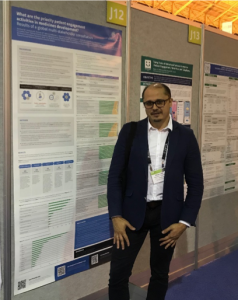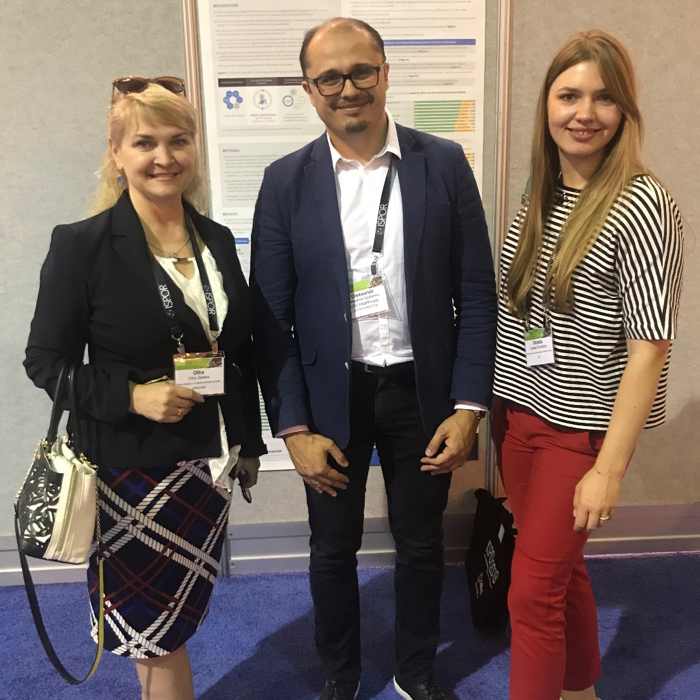Dr Oleksandr Gorbenko displayed a PFMD poster at the New Orleans conference, attracting strong interest from experts in health economics and outcomes
Patients are increasingly involved in clinical research as companies and academics seek to make their work more patient-centric and more efficient. But, in an era where healthcare economics has been dominated by austerity, how is the patient voice incorporated into key decisions on health economics, policy and access to innovation?
Dr Oleksandr Gorbenko, Global Patients Affairs Medical Lead at ViiV Healthcare, went to the US meeting of the International Society for Pharmacoeconomics and Outcomes Research (ISPOR) to find out – and to share the work of PFMD in advancing the field of patient engagement. As a member of the Core Team behind the PFMD Patient Engagement Framework, he is well placed to discuss these issues with global experts in health economics and outcomes research (HEOR).
Pharmacoeconomics is not a field renowned for patient involvement or transparency in decision-making, despite its significant contribution to patient-centred outcomes. ‘This can be a real pain point,’ explains Dr Gorbenko. ‘Decision-makers can be presented with scientific evidence for an innovative product or technology but still decide not to reimburse it. This can be frustrating for a lot of patients.’
PFMD poster
ISPOR’s US meeting attracted almost 4,000 healthcare stakeholders from more than 65 countries, including pharmacoeconomic experts working with governments and payers. Under the theme Rapid. Disruptive. Innovative. A New Era for HEOR, the conference addressed hot topics in the field and provided opportunities to share research through its poster exhibition.
‘I presented a PFMD poster, detailing our past work and ongoing activities,’ Dr Gorbenko said. ‘It was an opportunity to showcase the PE Quality Guidance, the Book of Good Practices and SYNAPSE, as well as ongoing PFMD workstreams.’
 The poster outlined the results of PFMD’s global multi-stakeholder consultation on priorities for patient engagement. ‘We looked at PE activities across five phases of medicines development: discovery, preclinical research, clinical research, regulatory review and post-approval,’ he added. ‘There are lots of examples across all three phases of clinical trials, but almost nothing in the discovery and regulatory phases.’
The poster outlined the results of PFMD’s global multi-stakeholder consultation on priorities for patient engagement. ‘We looked at PE activities across five phases of medicines development: discovery, preclinical research, clinical research, regulatory review and post-approval,’ he added. ‘There are lots of examples across all three phases of clinical trials, but almost nothing in the discovery and regulatory phases.’
Overall, 94 unique PE activities were included in the public consultation across the whole medicines’ development continuum.
Activities rated highly relevant across all phases included in the study were: understanding patient disease experience; lay patient communication and outreach; input into research aims and methodology. These findings are feeding into the work of six working groups covering all 94 identified PE activities across the medicine development continuum. In addition, PFMD has created working groups on training and plain-language summaries.
The insights from this public consultation will also be helpful as guidance for working groups to prioritise which PE activities to develop ‘How-to’ modules for, utilizing the developed PE Quality Guidance methodology.
Europe: East-West divide?
Dr Gorbenko received positive feedback during the poster exhibition, with several attendees downloading the Quality Guidance using the QR code displayed on the poster. ‘People also wanted details about the methodology – such as how we differentiated between real patients and patient advocates, activists and members of Patient Advocacy Groups (PAGs) and Community-Based Organisations (CBOs).’
One of the most intriguing questions was how PFMD and others can collaborate more closely with countries in Eastern Europe where cultural differences and existing stereotypes might influence attitudes to PE. ‘As someone from Ukraine, this is an issue close to my heart,’ he said. ‘I think we are still struggling in some Eastern European and Asian countries where there are major concerns about patient literacy, patient empowerment and the impact of patients on decision-making. Things are moving in some countries – including Poland, Czech Republic, Slovakia, Romania, Croatia, Hungary, Georgia, Ukraine, Bulgaria and the Balkan countries – but progress can be painfully slow.’
The ISPOR community has now established a patient-centred special interest group to address challenges in how health economics and outcomes researchers can become torch bearers for PE. ‘They are calling for a PE leadership team to develop methodologies, tools and trainings to accelerate progress,’ said Dr Gorbenko. ‘They have invited PFMD to participate so I look forward to seeing where this might take us.’

Dr Oleksandr Gorbenko with members of Ukrainian delegation: Prof. Olga Zaliska (left) and Dr Oresta Pinyazhko

































































